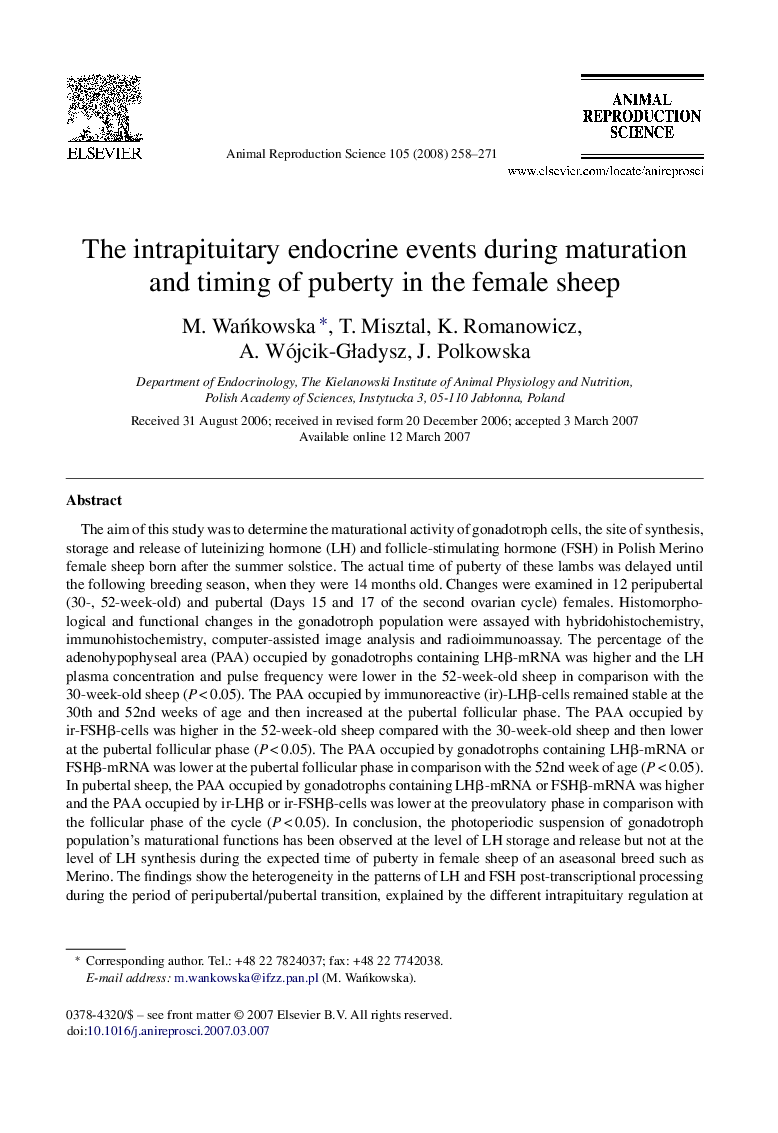| Article ID | Journal | Published Year | Pages | File Type |
|---|---|---|---|---|
| 2074398 | Animal Reproduction Science | 2008 | 14 Pages |
Abstract
The aim of this study was to determine the maturational activity of gonadotroph cells, the site of synthesis, storage and release of luteinizing hormone (LH) and follicle-stimulating hormone (FSH) in Polish Merino female sheep born after the summer solstice. The actual time of puberty of these lambs was delayed until the following breeding season, when they were 14 months old. Changes were examined in 12 peripubertal (30-, 52-week-old) and pubertal (Days 15 and 17 of the second ovarian cycle) females. Histomorphological and functional changes in the gonadotroph population were assayed with hybridohistochemistry, immunohistochemistry, computer-assisted image analysis and radioimmunoassay. The percentage of the adenohypophyseal area (PAA) occupied by gonadotrophs containing LHβ-mRNA was higher and the LH plasma concentration and pulse frequency were lower in the 52-week-old sheep in comparison with the 30-week-old sheep (P < 0.05). The PAA occupied by immunoreactive (ir)-LHβ-cells remained stable at the 30th and 52nd weeks of age and then increased at the pubertal follicular phase. The PAA occupied by ir-FSHβ-cells was higher in the 52-week-old sheep compared with the 30-week-old sheep and then lower at the pubertal follicular phase (P < 0.05). The PAA occupied by gonadotrophs containing LHβ-mRNA or FSHβ-mRNA was lower at the pubertal follicular phase in comparison with the 52nd week of age (P < 0.05). In pubertal sheep, the PAA occupied by gonadotrophs containing LHβ-mRNA or FSHβ-mRNA was higher and the PAA occupied by ir-LHβ or ir-FSHβ-cells was lower at the preovulatory phase in comparison with the follicular phase of the cycle (P < 0.05). In conclusion, the photoperiodic suspension of gonadotroph population's maturational functions has been observed at the level of LH storage and release but not at the level of LH synthesis during the expected time of puberty in female sheep of an aseasonal breed such as Merino. The findings show the heterogeneity in the patterns of LH and FSH post-transcriptional processing during the period of peripubertal/pubertal transition, explained by the different intrapituitary regulation at the level of post-transcriptional synthesis and storage rather, than at the level of release. Altogether, intrapituitary mechanisms of ovine maturation could have the histomorphological feature. Our observations prompt the hypothesis that the female lamb may be able to transduce changes in day length into the appropriate endocrine cues for sexual maturation after attainment by the pituitary gonadotroph population the full peripubertal efficiency, manifested by the sufficient storage of LH.
Related Topics
Life Sciences
Agricultural and Biological Sciences
Animal Science and Zoology
Authors
M. WaÅkowska, T. Misztal, K. Romanowicz, A. Wójcik-GÅadysz, J. Polkowska,
